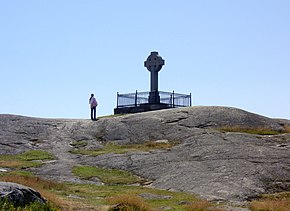Birca

Ansgars Cross in Birka
|
|
| Location | Ekerö Municipality, Sweden |
|---|---|
| Coordinates | 59°20′10.36″N 17°32′43.68″E / 59.3362111°N 17.5454667°ECoordinates: 59°20′10.36″N 17°32′43.68″E / 59.3362111°N 17.5454667°E |
| History | |
| Founded | 8th century |
| Abandoned | 10th century |
| Periods | Viking Age |
| Official name | Birka and Hovgården |
| Type | Cultural |
| Criteria | iii, iv |
| Designated | 1993 (17th session) |
| Reference no. | 555 |
| State Party | Sweden |
| Region | Europe and North America |
During the Viking Age, Birka ![]() listen (Birca in medieval sources), on the island of Björkö (literally: "Birch Island") in present-day Sweden, was an important trading center which handled goods from Scandinavia as well as Central and Eastern Europe and the Orient. Björkö is located in Lake Mälaren, 30 kilometers west of contemporary , in the municipality of Ekerö. The archaeological sites of Birka and Hovgården, on the neighbouring island of Adelsö, make up an archaeological complex which illustrates the elaborate trading networks of Viking Scandinavia and their influence on the subsequent history of Europe. Generally regarded as Sweden's oldest town, Birka (along with Hovgården) has been a UNESCO World Heritage Site since 1993. A silver ring from a Viking-era grave in Birka is the first ring with Arabic inscription from that era found in Scandinavia.
listen (Birca in medieval sources), on the island of Björkö (literally: "Birch Island") in present-day Sweden, was an important trading center which handled goods from Scandinavia as well as Central and Eastern Europe and the Orient. Björkö is located in Lake Mälaren, 30 kilometers west of contemporary , in the municipality of Ekerö. The archaeological sites of Birka and Hovgården, on the neighbouring island of Adelsö, make up an archaeological complex which illustrates the elaborate trading networks of Viking Scandinavia and their influence on the subsequent history of Europe. Generally regarded as Sweden's oldest town, Birka (along with Hovgården) has been a UNESCO World Heritage Site since 1993. A silver ring from a Viking-era grave in Birka is the first ring with Arabic inscription from that era found in Scandinavia.
Established in the middle of the 8th century and thus being one of the earliest urban settlements in Scandinavia, Birka was the Baltic link in the river and portage route through Ladoga (Aldeigja) and Novgorod (Holmsgard) to the Byzantine Empire and the Abbasid Califate. Birka was also important as the site of the first known Christian in Sweden, founded in 831 by Saint Ansgar.
...
Wikipedia
